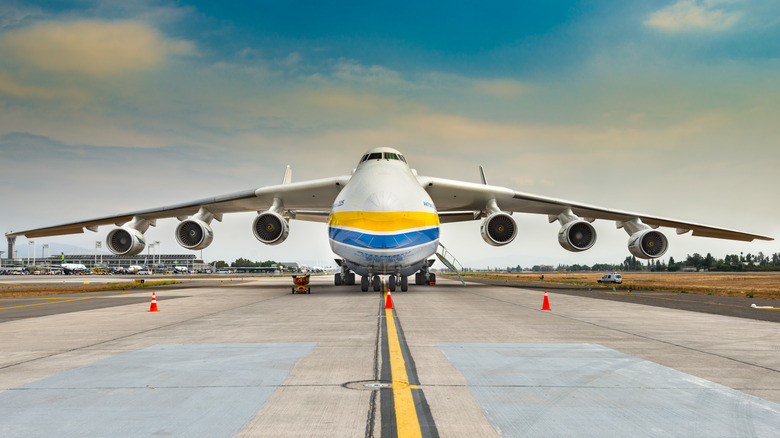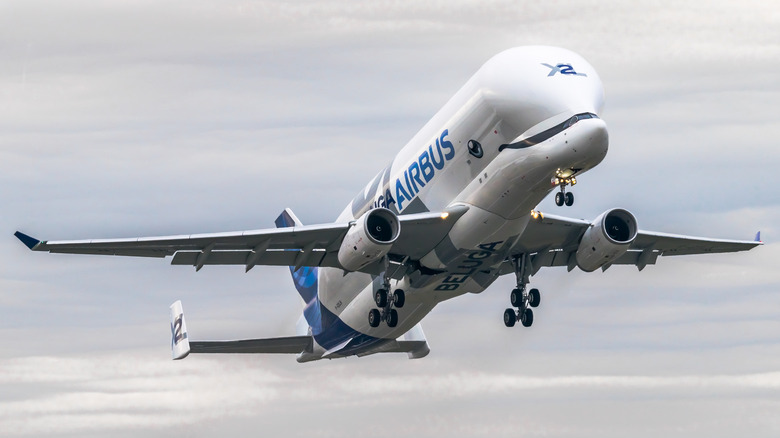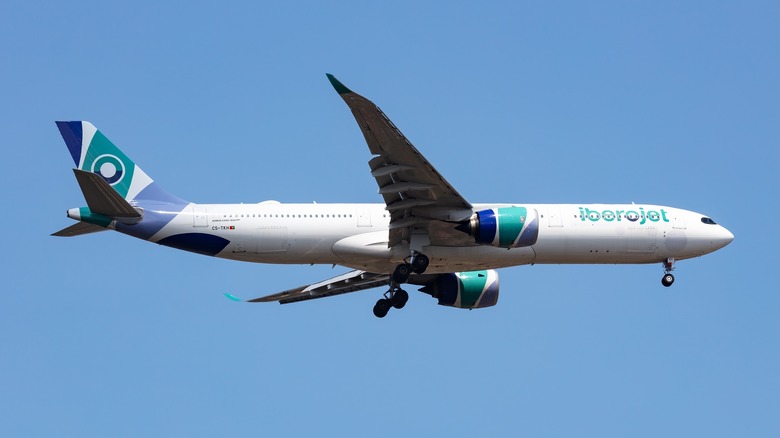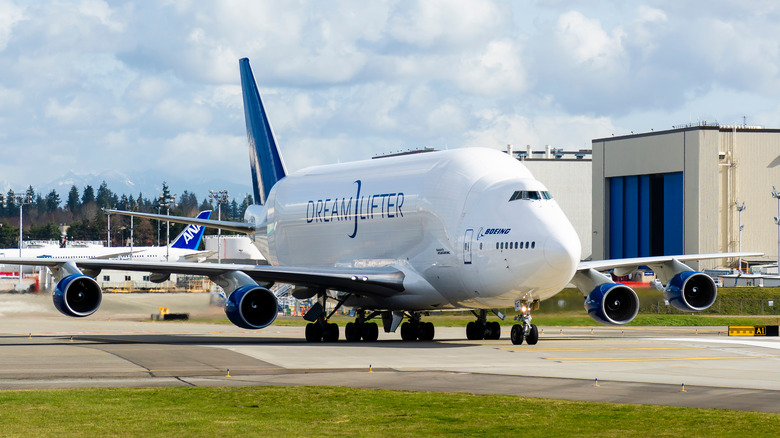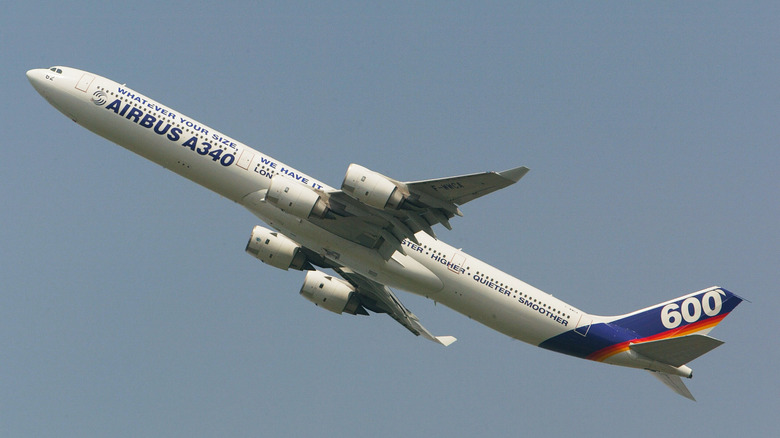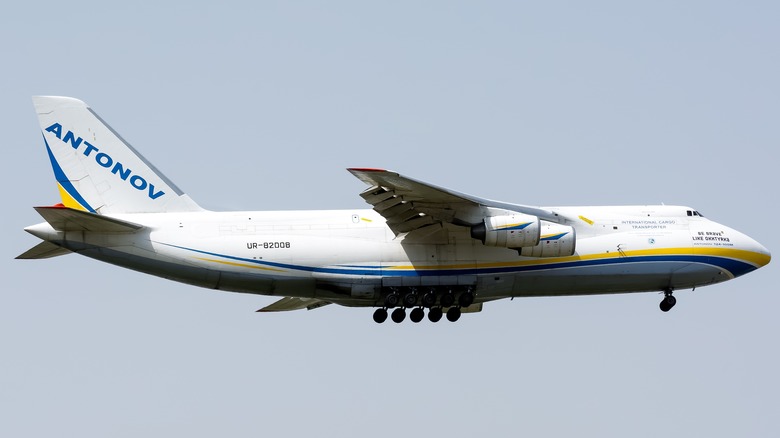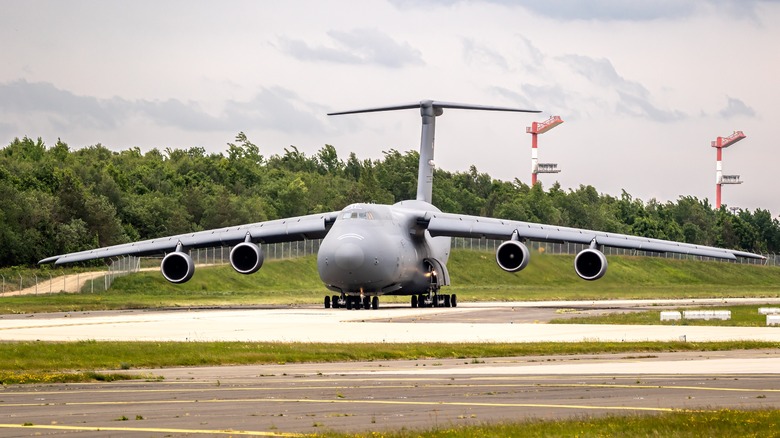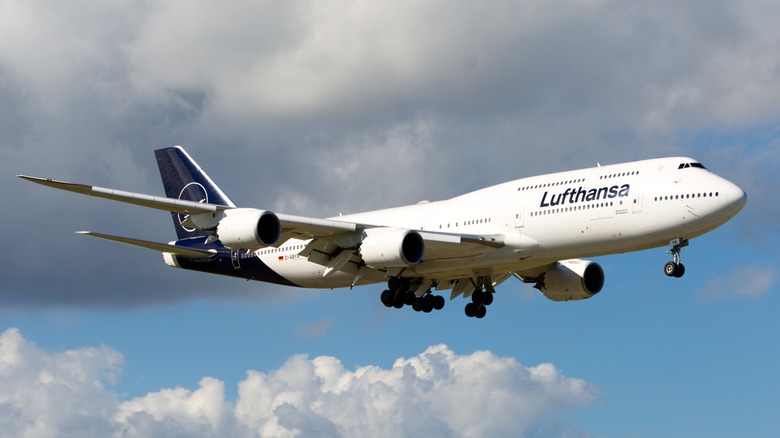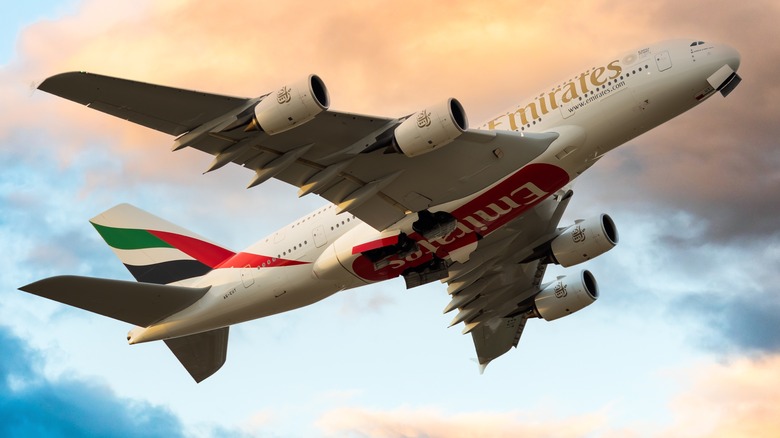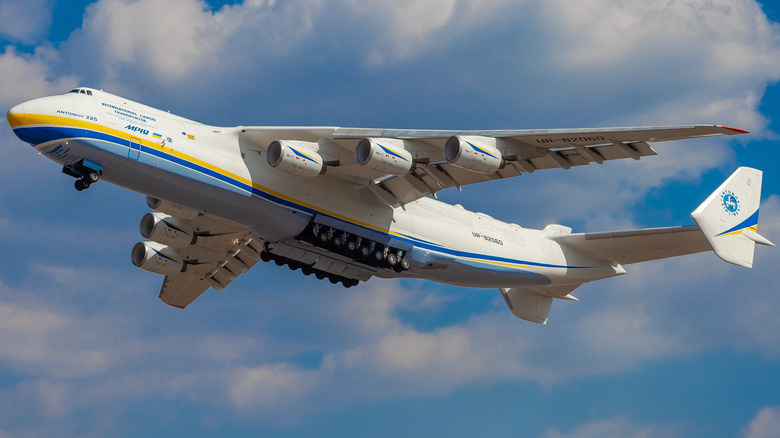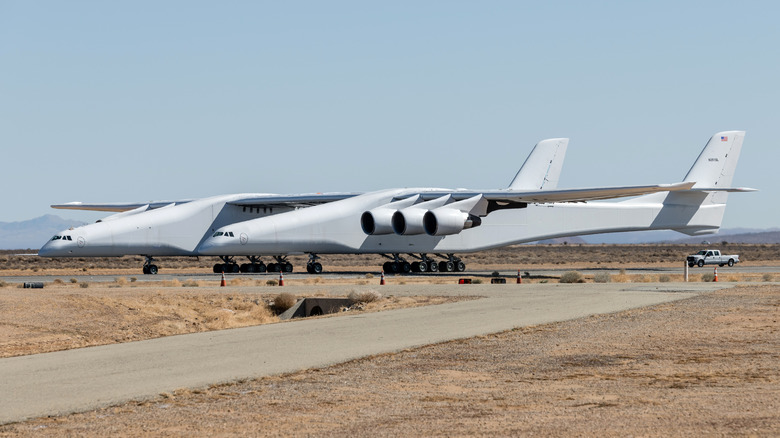10 Of The Biggest Jets Ever Made, Ranked By Size
It's not been an easy few years for the aviation industry. From passenger numbers plummeting due to the pandemic to fuel costs spiking in the face of global conflicts, there has been a seemingly never-ending list of headaches for airline bosses to deal with. Throughout the instability, it's the world's largest planes that have proven especially critical to the fate of their owners. Some became outsized liabilities as they sat on the tarmac devoid of passengers, while others became especially useful for transporting huge amounts of cargo to places in need.
As pandemic worries have subsided and passenger numbers have rebounded, many of the biggest passenger jets are being recommissioned to meet the swell in demand. Likewise, cargo carriers have proved invaluable in the transport of goods and equipment to areas hit by conflict or disasters. In short, the world's largest aircraft are taking to the skies again, en masse.
There's no perfect way to rank these flying giants by size, so to help visualize just how large they are, we've ranked them by how much tarmac they'll take up at an airport — that is, length times wingspan. Some are designed to carry passengers, while some carry outsized cargo, but no matter what they're built for, they're all among the largest aircraft in the sky.
Airbus BelugaXL -- 40,956 square feet
Undoubtedly one of the most unique-looking aircraft in the sky, the BelugaXL, as its name suggests, looks like a giant flying beluga whale. It was designed to replace Airbus' existing fleet of five Beluga aircraft, whose job was to transport aircraft parts between the company's various facilities around the world. Airbus has manufacturing facilities across Europe and in China, and the ability to quickly transport parts like pre-assembled wings between those facilities is vital to keeping its manufacturing operations running smoothly.
The first BelugaXL was assembled in 2018 and all five planned units are scheduled to be completed by the middle of this decade. The first examples are already in service, and can occasionally be seen at passenger airports, including in 2022 when London Luton Airport passengers were treated to the sight of it performing a training exercise in between scheduled flights. The aircraft's 207 ft length and 197 ft 10 in wingspan doesn't fully describe the aircraft's size — instead, it's the bulbous fuselage that's the real headline feature, with a huge 30% increase in cargo capacity compared to the original Beluga, and a maximum payload of 51 tons.
Airbus A330-900 -- 43,855 square feet
The largest A330neo variant is the A330-900, with capacity for up to 460 passengers. It's one of the more popular variants of the family, and is operated by 18 airlines, the largest of which is Delta. The widebody aircraft was developed as a replacement for the original A330 line, with its Rolls-Royce Trent 7000 helping to reduce costs compared to its predecessor. In the wake of renewed scrutiny of the damaging environmental impacts of mass air travel, operators also began demanding more eco-friendly aircraft, and Airbus says the latest A330neo engines emit 25% less carbon dioxide than older models.
That decrease in emissions is down to their reduced fuel consumption — another key area of appeal for operators considering the unpredictability of fuel prices in recent years. For passengers, the latest generation promises a more modern cabin with up-to-date tech including standard wi-fi capabilities. More than 100 A330-900 aircraft have reportedly been delivered, with an additional 200 orders on the books.
Boeing 747 Dreamlifter -- 49,703 square feet
Boeing's answer to the Airbus BelugaXL is the 747 Dreamlifter. It's built to haul 787 Dreamliner aircraft parts between the company's global facilities, and four examples are in service. It's primarily only seen at the airports adjacent to Boeing and its suppliers, but in 2013, made headlines when it landed at the wrong airport in Kansas by mistake. Rather than landing at McConnell Air Force Base as planned, it instead touched down at Colonel James Jabara Airport, a small airport without a control tower that was roughly nine miles away.
Despite the runway being considerably shorter than the plane would usually require, the Dreamlifter made a safe takeoff and eventually landed at the correct airport. Reports did note that a fresh set of pilots were drafted in to ensure that no further mistakes were made.
When it's not transporting aircraft parts, the Dreamlifter is occasionally lent out by Boeing for transporting other oversized cargo, including a huge shipment of PPE from Chinese suppliers to America during the Covid-19 pandemic. However, since the 787 is the best-selling widebody ever made and 2023 saw even more orders added to the books, it's likely to be kept busy shuttling parts across the globe for the foreseeable future.
Airbus A340-600 -- 51,469 square feet
With room for 320 passengers in standard configuration and up to 475 passengers in high-density configuration, the Airbus A340-600 is one of the European firm's largest aircraft in production. It's the longest variant of the A340 line, and boasts a range of 7,800 nautical miles, enabling it to connect many of the world's largest hubs. The first example was delivered in 2002, and since then, a number of the world's largest carriers have taken delivery of the aircraft, including Emirates and Lufthansa.
To achieve the extra cabin space compared to other A340 variants, Airbus increased the length of the fuselage, making it the manufacturer's longest jet in operation today. Its flight deck is also designed to be as similar as possible to other A340 variants in order to reduce pilot training time — it reportedly only takes a day or two of training for pilots to be certified to fly the A340-600 if they've already flown other models in the line.
Antonov An-124-100 Ruslan -- 54,480 square feet
While its cargo capacity falls a little short of its now-destroyed successor, the An-225, the Antonov An-124-100 Ruslan is still a formidable cargo carrier. In fact, it's now the largest surviving cargo plane in the world. In 1994, it set the world record for carrying the heaviest piece of cargo, a General Motors locomotive, from Canada to Ireland. The trip required multiple refueling stops and took 12 hours in total. The total payload, including the equipment required to secure the locomotive, was 146 tons.
The aircraft was originally built by the Soviet Union, and all remaining examples still in service today are either owned by Ukraine or Russia. Several of the Russian-owned aircraft are currently grounded abroad after sanctions prevented their use, but others remain in the country and are reportedly used in the war effort. Likewise, Ukraine's Ruslans have been used to help the country ship in military equipment from various allies around the world.
Lockheed Martin C-5M Super Galaxy -- 55,210 square feet
The C-5M Super Galaxy is the largest aircraft in the U.S. Air Force's fleet, with a cargo capacity of 281,001 pounds. It's used to transport enormous amounts of equipment to U.S. bases (and those of allies) across the world, and features several innovations to make it as efficient as possible. That includes the dual loading doors — both the front and rear ends of the aircraft lift open to allow cargo to be loaded and unloaded simultaneously.
The aircraft can carry up to five helicopters, and features drive-on ramps at both ends of the cargo bay with room for two rows of vehicles to be carried. It can be refueled in mid-air, and so theoretically has unlimited range with the appropriate support. The C-5 Galaxy has been flying since 1970, but after several decades of service, a modernization program began around the turn of the century, leading to the updated "C-5M" aircraft in service today.
Boeing 747-8 -- 56,145 square feet
After 56 years of production, Boeing recently ended production of its veteran 747 model, with over 1,500 examples of the aircraft sold. The most recent iteration of the aircraft, the 747-8, took its first flight in 2010, and boasted an even larger wingspan than its predecessor, at 250.2 feet. Among the last customers of the 747-8 was the U.S. Air Force, which commissioned replacements for the president's Air Force One fleet. The latest plane boasts a variety of improvements over the outgoing 747-200 presidential aircraft, including a longer range, lower emissions, and a faster cruising speed.
The 747-8's cruising speed is the fastest of any passenger jet in the world, at 0.855 Mach. While the aircraft is no longer in production, its enduring popularity among both passengers and operators will ensure it remains a familiar sight in the skies for many decades yet. However, its fate was sealed long ago by the arrival of newer, more efficient planes and higher passenger demand for short-haul flights, so despite the 747's iconic status, it was always going to end up on the chopping block.
Airbus A380 -- 62,446 square feet
The A380 is the world's largest passenger plane, with room for up to 545 passengers in a four-class configuration and a maximum seating capacity of 853 passengers. Its huge size means that it's only viable for use on the world's busiest routes, and it's only operated by a select few major airlines. These include Middle Eastern carriers like Emirates and Qatar Airways, as well as European carriers like British Airways and Lufthansa. Its wingspan stretches 262 feet, meaning it dwarfs even other long-haul aircraft when it's on the tarmac.
Production of the A380 ended in 2021 after 251 examples had been sold, but Airbus says it will continue to support the aircraft for decades into the future. How long the existing aircraft will remain in service is unknown — some examples were mothballed during the Covid-19 pandemic, but a few are now being returned to service as demand once again increases. While the A380 was always a rare aircraft by modern standards, its status as the undisputed king of the passenger jets earned it a spot on our list of the most iconic airplanes in aviation history.
Antonov An-225 Mriya -- 79,750 square feet
The Antonov An-225 Mriya was, until 2022, the largest cargo plane on Earth. A takeover by Russian forces of Hostomel Airport, near the Ukrainian capital, Kyiv, saw the plane caught in the fighting, and subsequently destroyed. It was one of a kind: Originally, two examples of the An-225 were due to be built, but the collapse of the Soviet Union in 1991 saw the second example abandoned before completion.
The finished plane served a variety of purposes in the decades since it was built, entering commercial service in 2002 and carrying unusual, heavy loads for both private contractors and governments. It also played a key role in delivering vast amounts of medical supplies around the globe during the pandemic, and was sitting awaiting its next job in Ukraine when it was caught in the firefight.
Photos from the scene show the plane to be irreparably damaged, but there's still a small chance that a resurrected An-225 might fly again one day. The second example that was never completed is still in storage at an Antonov facility, and Ukrainian president Volodymyr Zelenskyy has vowed to complete it once the war is over. Various funding initiatives have been launched to help the project, including within Microsoft Flight Simulator, but for now it remains unknown whether the aircraft will ever return to the skies.
Stratolaunch Roc -- 92,015 square feet
The world's largest plane by wingspan is the Stratolaunch Roc, a unique aircraft built to launch hypersonic vehicles at heights of around 30,000 feet. It consists of two Boeing 747-400 aircraft bodies that were rebuilt and connected to make one giant craft with a wingspan of 385 feet. It uses six jet engines built by Pratt & Whitney for thrust and weighs 1.3 million pounds without its payload. Originally, Stratolaunch was founded by Microsoft co-founder Paul Allen with the goal of providing a cost-effective way to launch satellites into space, but after his death in 2018, the company was forced to reinvent itself to stay solvent.
It pivoted to using the Roc aircraft to launch hypersonic vehicles for military and private commercial testing, and is now developing its own hypersonic vehicle alongside continuing the development of the Roc. So far, the Roc has taken a number of test flights, including one lasting six hours; its first vehicle launch for paying customers is scheduled for the end of 2023. The company aims to expand the business with both government and private contracts in the coming years, hopefully keeping the Roc a regular sight in the skies of California as a result.
